Throughout history, hundreds of talented watchmakers have left their mark on the science and industry of timekeeping.
There have been those who have revolutionized the field with the invention of something groundbreaking such as Thomas Mudge and his lever escapement in 1755 or George Daniels and the co-axial escapement in 1974.
There are those who have solved smaller problems like Albert Pellaton, who patented a new winding system in 1946 while working for IWC.
And then there are those who have simply dared to create something unique like the famous automata by Pierre Jaquet-Droz.
Big or small, clever watchmakers have been leaving their marks on history in a variety of ways. And while many inventions were later overshadowed by newer inventions – or completely replaced by newly discovered technology – their achievements are celebrated as part of the story that is horology.
Today we launch a new series designed to highlight watchmakers living and working today that have already left a significant mark on the industry – and horology as a whole. Some are part of large brands, some are independents, and some are the occasional mad genius defining a new path for the future of horology.
We call this series Watchmakers of Historical Significance (WOHS) for short. Pronounced like the word “whoa,” WOHS provides a chance to focus on those contributing to the legacy of watchmaking and a glimpse into the minds behind the loupe. And if we are lucky, WOHS makes at least one reader exclaim “whoa” by the end.
For the inaugural edition of WOHS, I highlight an engineer who has used technology to push forward since his beginnings, creating a company that is not only a leading brand among independents, but also a supplier to many established brands.
The man I am referring to is the incredible yet humble Romain Gauthier.
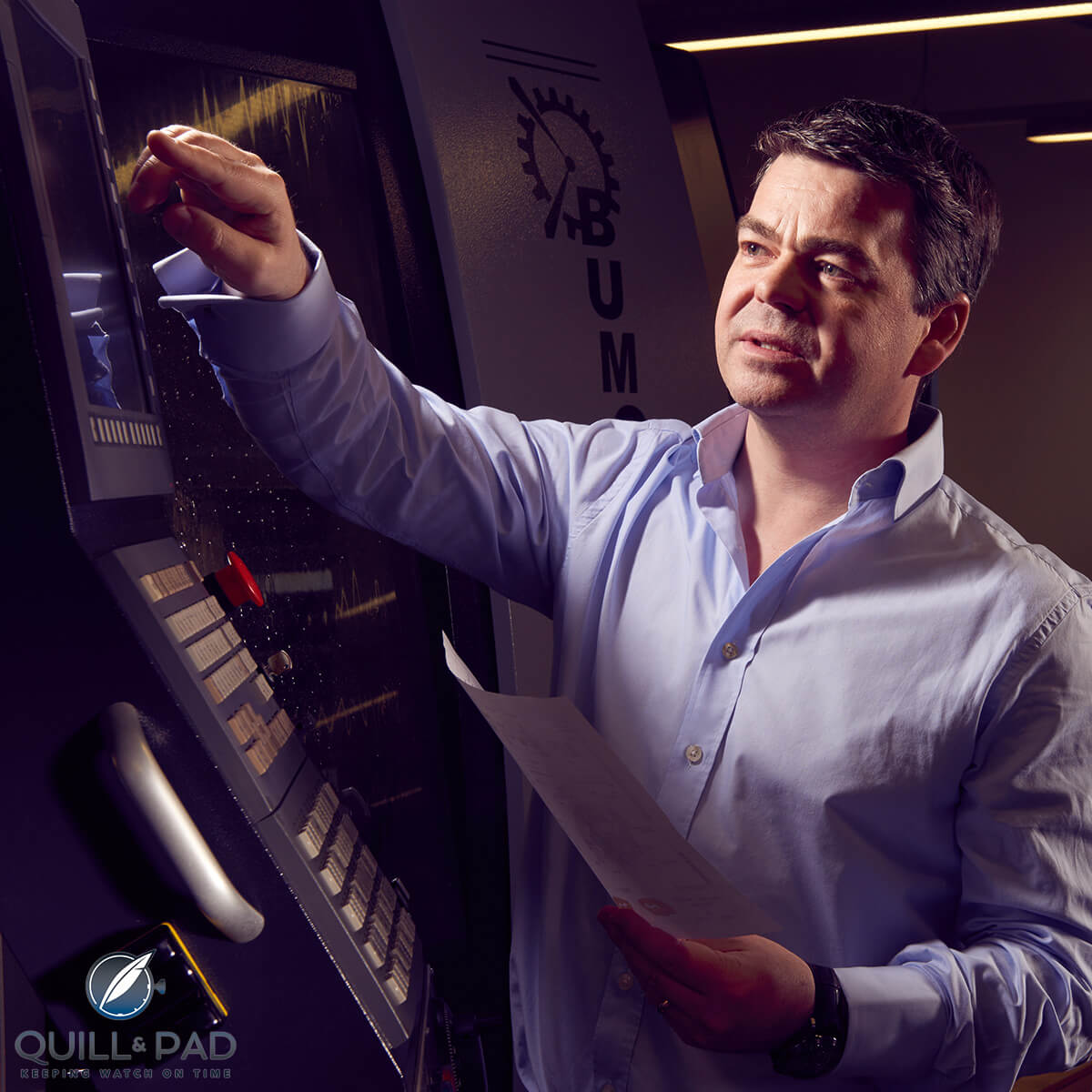
Romain Gauthier programming the machining of components at Manufacture Romain Gauthier
Romain Gauthier: background
Gauthier started his career by getting a diploma in precision mechanics and further training in machine-tool construction. He then began a nine-year stint with François Golay S.A., where he focused on precision turning of wheels and other components for timepieces.
After a few years spent honing his skills manufacturing complex and precise components, Gauthier realized that he wanted to take those skills and do his own thing.
His personal philosophy of precision and quality being what it is, this meant there was only one thing to do: expand his business knowledge and skills. So Gauthier returned to school to get his MBA because he knew you need more than just a great watch to build a brand: you need to consider every aspect of a business and do it right. That is the only way to truly succeed.
He knew that learning the ins and outs of business was vital to the success of the ideas he had in his head, and the last 15 years have proven him correct. Gauthier graduated with honors (an exceptional feat considering he was also still working during his master’s program) and proceeded to move forward with his dreams of creating a brand.
With permission from his superior, he worked for more than two years to develop his first movement using the company’s machines on nights and weekends.

Romain Gauthier Prestige HM in red gold
He set up a new company, Romain Gauthier S.A., and finalized his new creation, the Prestige HM. Once he thought it was ready, Gauthier turned to Philippe Dufour as a mentor to guide him through many of the pitfalls of launching a boutique brand. Dufour proved critical to developing his distribution with priceless contacts around the world.
The reception for his watch (and brand) was strong, but Gauthier wasn’t going to coast on the relative success of this launch. He positioned his company not only as an independent watchmaker, but also as a specialist supplier for the pesky hard-to-machine components that most suppliers won’t even quote.
Having built good contacts around the industry from past classmates and old co-workers, he soon became a trusted resource to the industry. Early advanced payments allowed him to purchase machines and grow the company without losing control to investors.
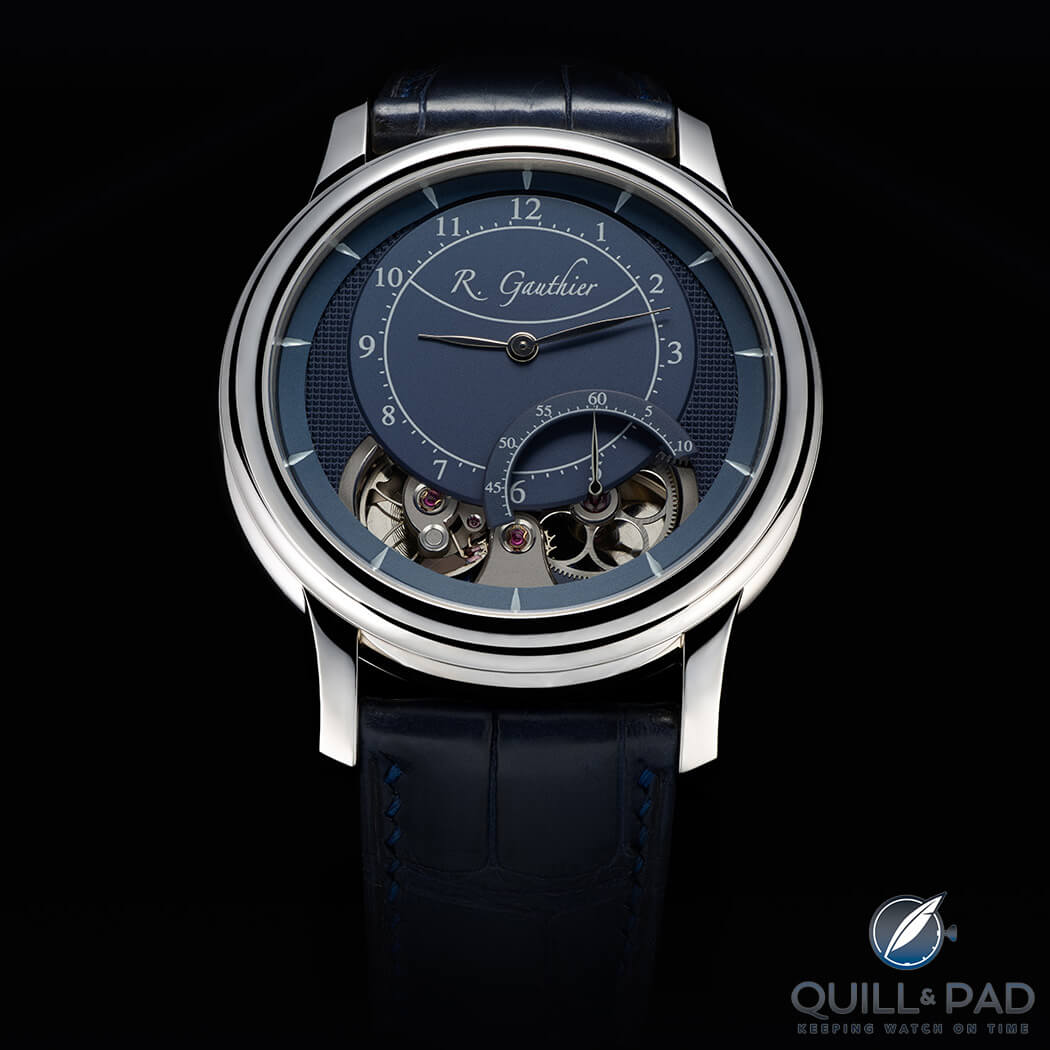
Romain Gauthier HMS Ten in platinum
As the business grew Gauthier focused on providing a stable base, which led to a minority investment from Chanel, infusing the company with not only funding but also a new creative outlet to keep the horological juices flowing in Le Sentier (see Surprising Ties That Bind: Chanel And Romain Gauthier).
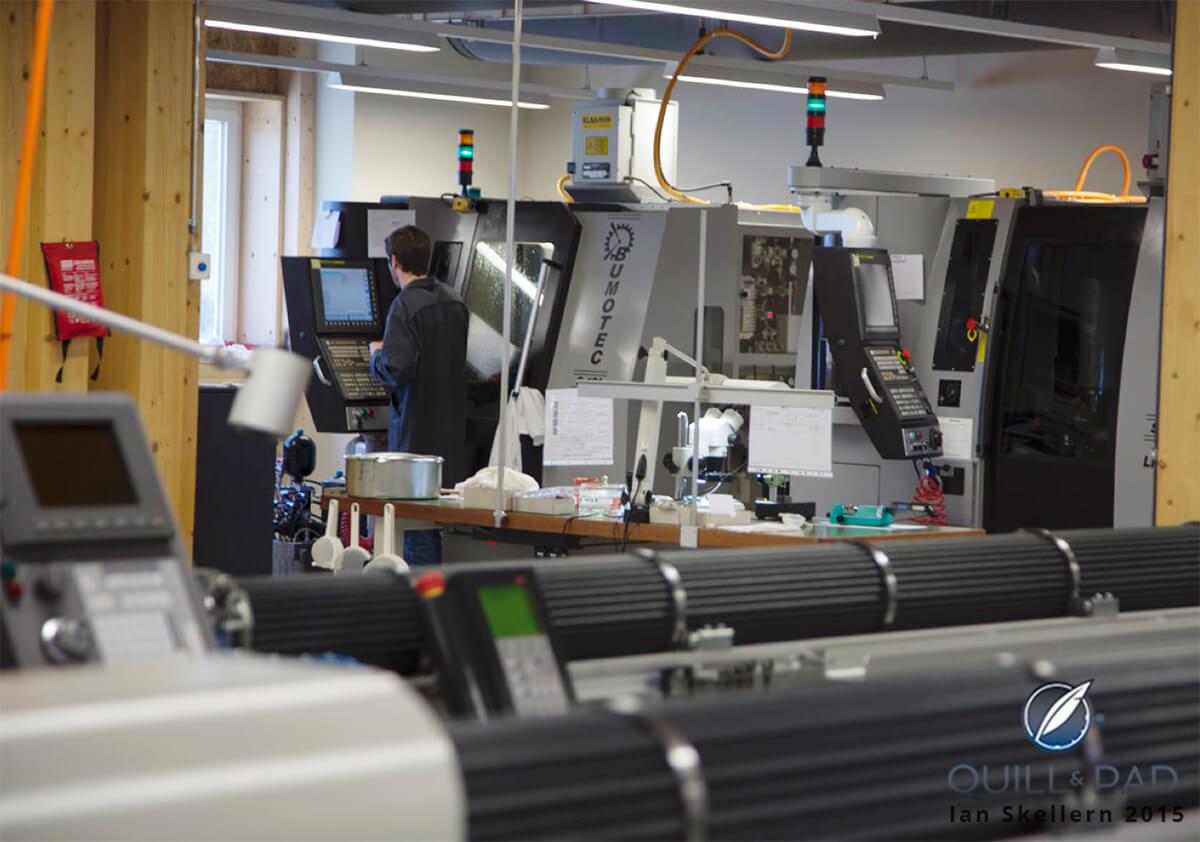
CNC machines in the background with automatic lathes in the foreground at Manufacture Romain Gauthier
Today the company boasts more than 20 talented employees and a state-of-the-art manufacture with a variety of CNC mills and lathes. These machines produce the components for around 100 Romain Gauthier watches a year, powered by four in-house movements, as well as complex components for other high-end brands.
Of course, Romain Gauthier is still at the center of it all driving innovation and creativity while building a team that creates some of the best watches available.
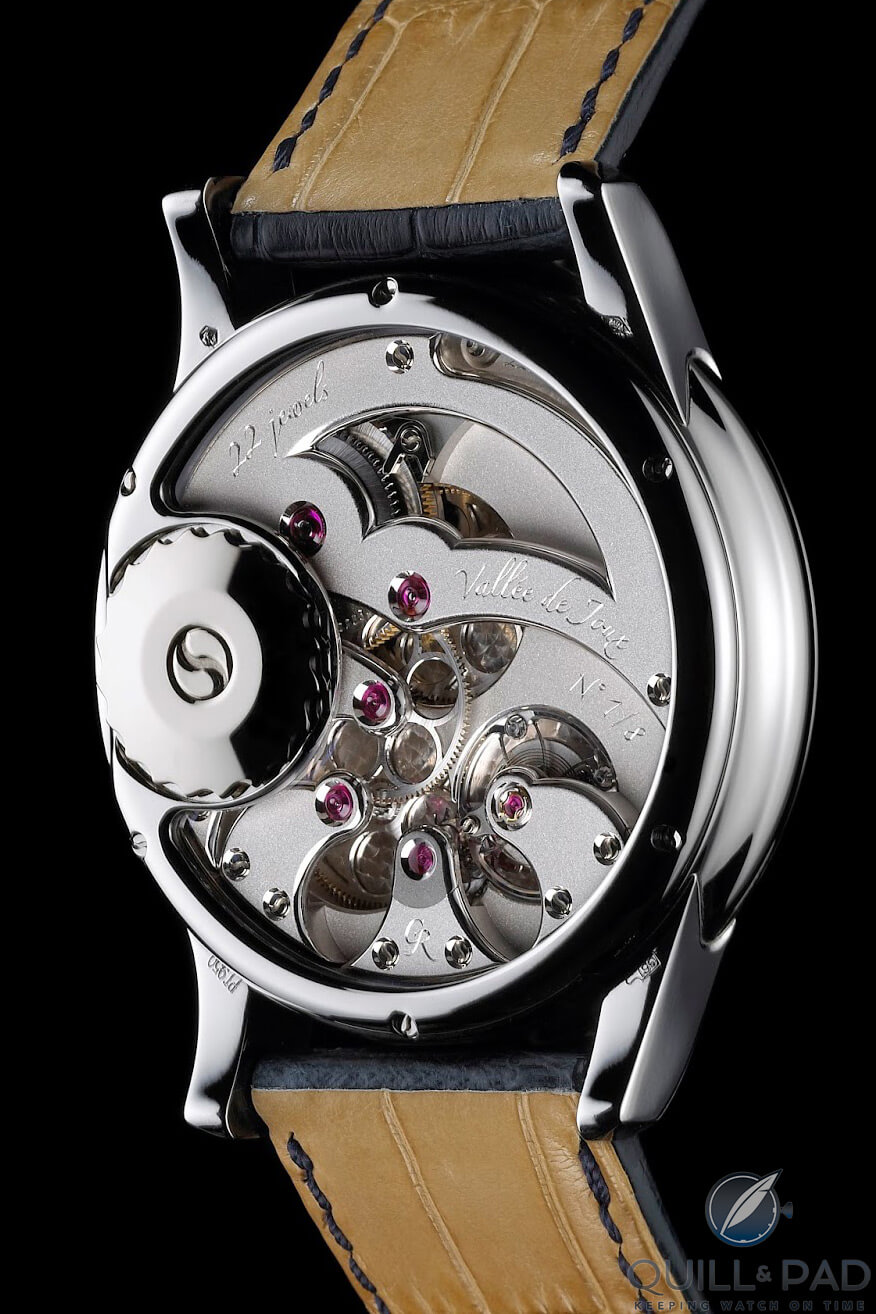
Movement of the Romain Gauthier Prestige HM in platinium
Romain Gauthier: contributions to the industry
This brand’s success is largely thanks to Romain Gauthier’s 20 years of passion and experience in creating things to the best of his ability.
Many individuals would simply get a job after graduation, but Gauthier was never satisfied leaving well enough alone. Getting a master degree while working full time is an accomplishment in itself, but the fact that it was immediately followed by developing his own caliber and founding a brand shows that he wasted no time in pursuing his goals.
His goals, while personal, have also resulted in changes to the watch industry in more than a few ways. Firstly, as a supplier, Gauthier and his team have not only helped realize the watches produced by Romain Gauthier, but they have been critical to forwarding horological capabilities across the board.
It is hard to know just how many timepieces wouldn’t exist if it wasn’t for Gauthier and his team. Specializing in the type of complex components that nobody else wants to (or knows how to) make puts Gauthier in the middle of some of the most ambitious projects in watchmaking. And his dedication to precision and beauty means these components also look good.
But being a supplier, even a highly skilled one, doesn’t necessarily get you into the history books; innovation does.
Like many before him, Gauthier is also a bit of a perfectionist (a slight understatement to be sure), and in designing his movements he looked for ways to improve on old ideas. One of the first of these is small yet important: a redesigned pallet lever.
Realizing that the traditional Swiss lever escapement is a slightly poor design (probably due to manufacturing limitations when it was invented), Gauthier set out to improve it in at least one way. The result was to create a triangular escape lever, a departure from the typical T-shaped lever that is nearly ubiquitous among mechanical watches made today.
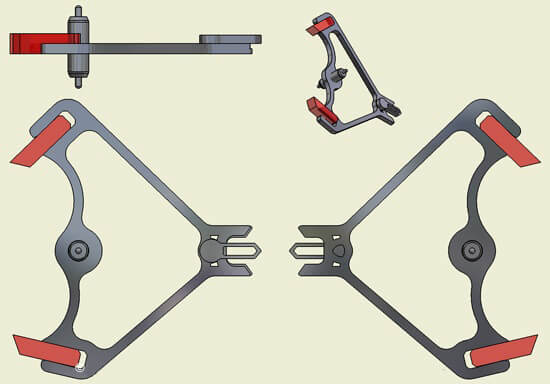
Romain Gauthier triangular escape lever
From a strictly engineering standpoint, the Swiss lever is heavier and less dimensionally stable than it could be. This is because the pallets are mounted on arms that are unsupported in the opposing direction from where the force is exerted.
This means that the arms and pallet stones can flex and deflect, changing the release point and variably altering the efficiency of the escapement and introducing vibrations that increase wear over the long run. It also can mess with the rate of the balance if the escapement release is not consistent.
The triangle fixes all of these by providing a rigid shape that resists deformation, is lighter, and maintains dimensional stability, allowing for increases in efficiency and a reduction in wear over time. It also allowed for an increase in balance amplitude by 15 degrees, which aids in rate stability and a slight increase in shock resistance.
Not many watchmakers can claim to have improved on the basic Swiss lever escapement, so that makes Gauthier a member of a rather exclusive club.
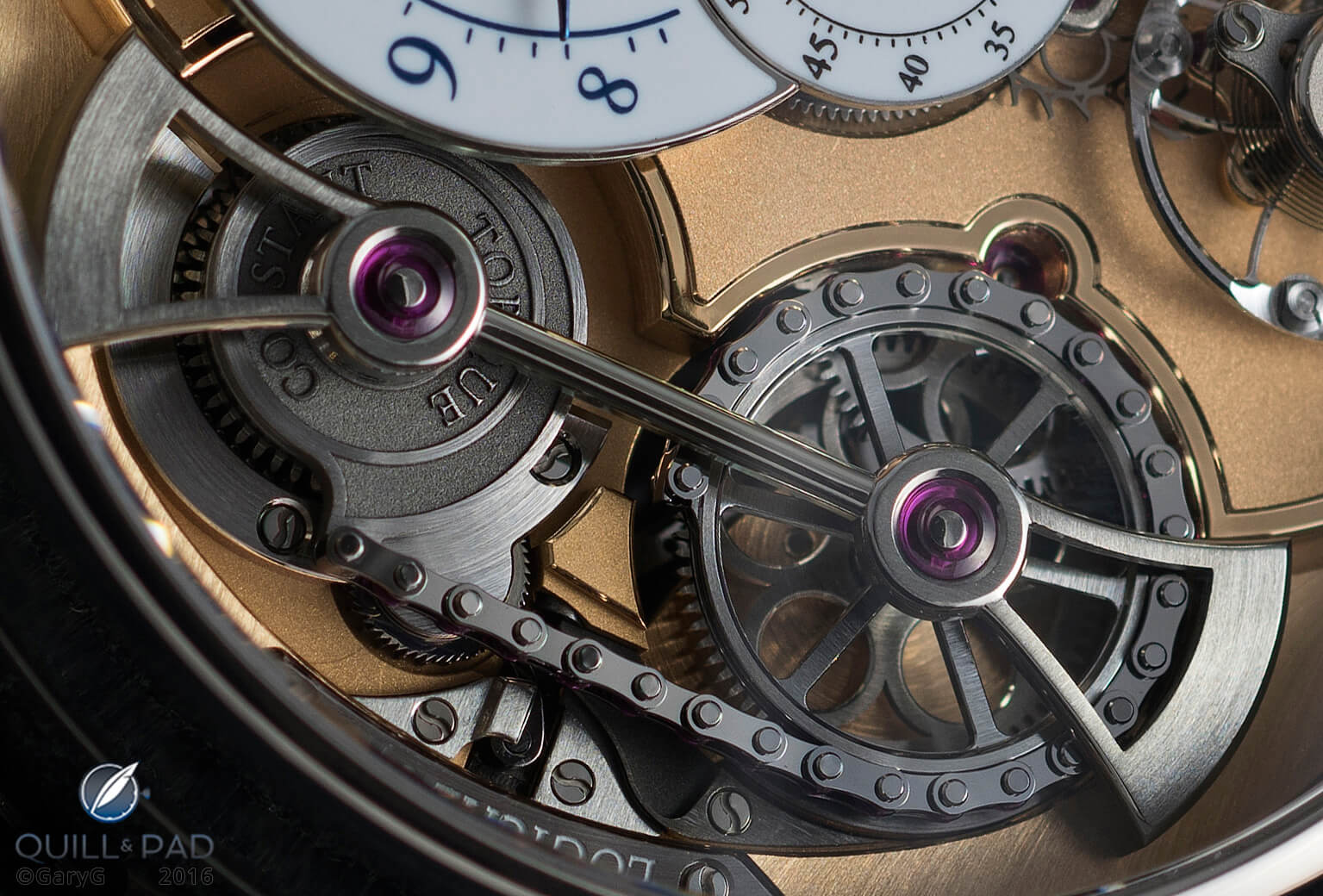
Innovation in action: constant torque assembly of the Romain Gauthier Logical One
But it doesn’t stop there: Gauthier also developed a constant force mechanism that is a new take on the vintage fusée and chain, which uses a much more efficient snail cam partnered with a short ruby-roller chain instead of using a fusée cone (see In Focus: Romain Gauthier’s Breathtaking Patented Ruby Link Chain From Logical One).
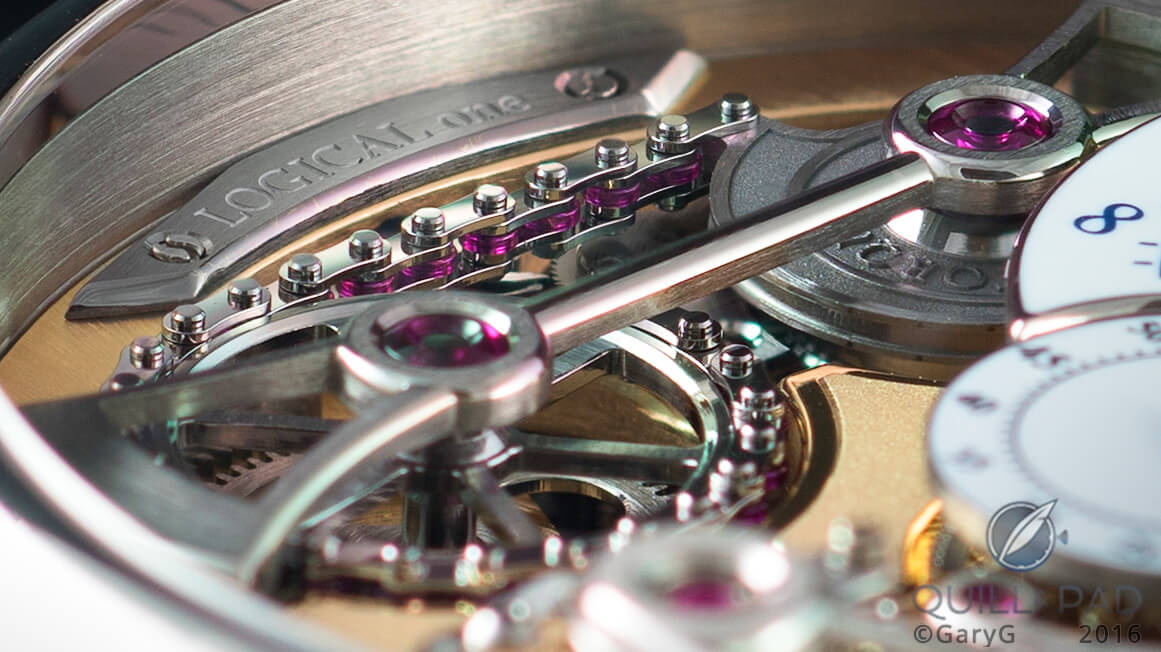
Movement detail showing ruby bearings on constant torque chain of the Romain Gauthier Logical One
The fragile nature of a traditional fusée-and-chain mechanism is compounded by the fact that it can also introduce friction that can reduce the power reserve. It also requires a miniscule chain that is difficult to assemble and repair. Finally, the physical shape of the system necessitates a fairly thick mechanism, which increases movement size to often undesired dimensions. The snail cam constant force mechanism inside Gauthier’s Logical One avoids all of these issues and looks darn good to boot.
The carefully designed cam uses less than one full turn over the entire power reserve compared to the two to three revolutions of the traditional fusée cone. Since the chain doesn’t need to wrap around multiple times in a small area or change vertical position, it can be made much larger and allow for design changes that reduce friction and increase ease of assembly and repair as well as provide better transmission of power.
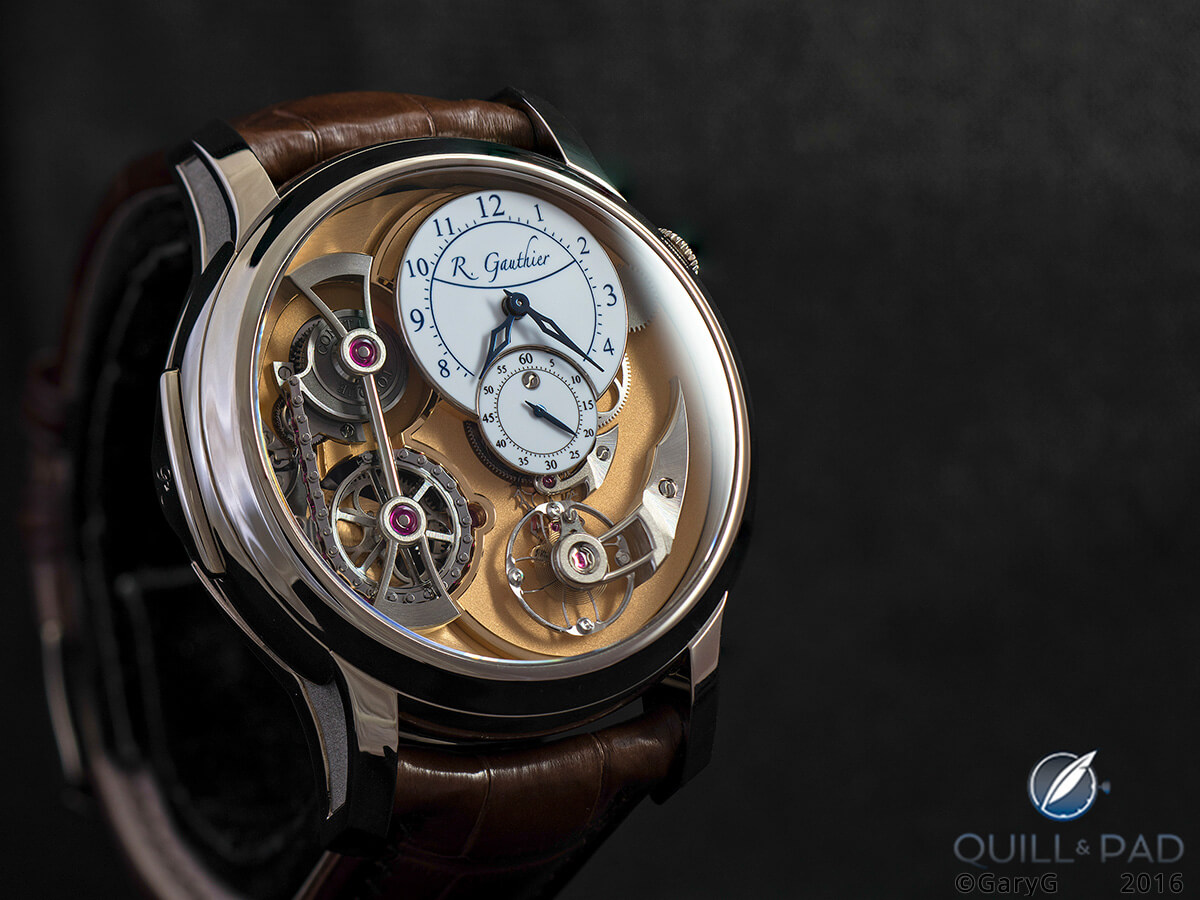
A lot to love: Romain Gauthier’s Logical One in white gold
Instead of a bunch of miniscule metal plates and pins that are only held together by the careful act of straight graining the surface (really), the links in the Logical One are held together like a more typical chain with snap clips. The metal pins are surrounded by ruby rollers which allow chain, pulley, and cam to operate with nearly no added friction.
The mechanism truly is an innovative look at a traditional solution that is inherently flawed due to capabilities available when it was invented. It takes a very creative person to effectively look to the past to find the paths of the future.
Romain Gauthier: personal philosophy
And that’s just a few of the benefits the industry will reap from this engineer who is not a trained watchmaker.
All of Romain Gauthier’s accomplishments, be they specifically horological or entirely business oriented, come from Gauthier’s personal philosophy about work and life. His inventions and his work ethic stem from the way that he looks at problems and how he relates to his own desires and goals.
I wanted to know more about why he has been as successful as he has, and I was able to get him to answer rather frankly about how he thinks and what drives him to keep pushing forward.
It turns out he is a pragmatist about pretty much everything. Throughout his career he has faced challenge after challenge, and he has always approached them in the same basic way: never underestimate what you want to do and you will be able to achieve anything you set your mind to.
You see, Gauthier believes that, as a rule, you must always believe that what you hope to accomplish will be difficult, even extremely difficult, because if you move forward with the idea that your goals require hard work and dedication and nothing is going to come easy, you are more prepared to achieve in the face of adversity.
This results in a level of constant professionalism that intermingles with every task undertaken. Taking something seriously and acting in the most professional way possible, goals ̶ especially lofty goals ̶ become a series of tasks that must be tackled in time. No rushing ahead, no assumptions about feasibility, no arrogance about skill; only steady and resolute hard work.
But don’t for a minute think that Gauthier doesn’t dream big. On the contrary, it is this method of looking at the wildest of dreams that makes them seem achievable in every instance. It is the foundation for his success in the long run.
Some might think this means he sees his greatest achievements as making his first watch or creating a thriving brand. While he is very happy to have done those things, he says his greatest accomplishments are becoming a respected watchmaker among his peers and helping to build a fantastic team of people that together created the Logical One as a successful timepiece.
In fact, the Logical One represented the point that he knew he had achieved what he wanted: the creation of a brand and a team that works together to create amazing watches that will last.
I followed up and asked what his single most important goal for the future was and he simply stated that he wanted to build a successful team and leave something that lasts for generations to come. Given the incredible craftsmanship and engineering put into every single Romain Gauthier watch, I would say he has already achieved that.
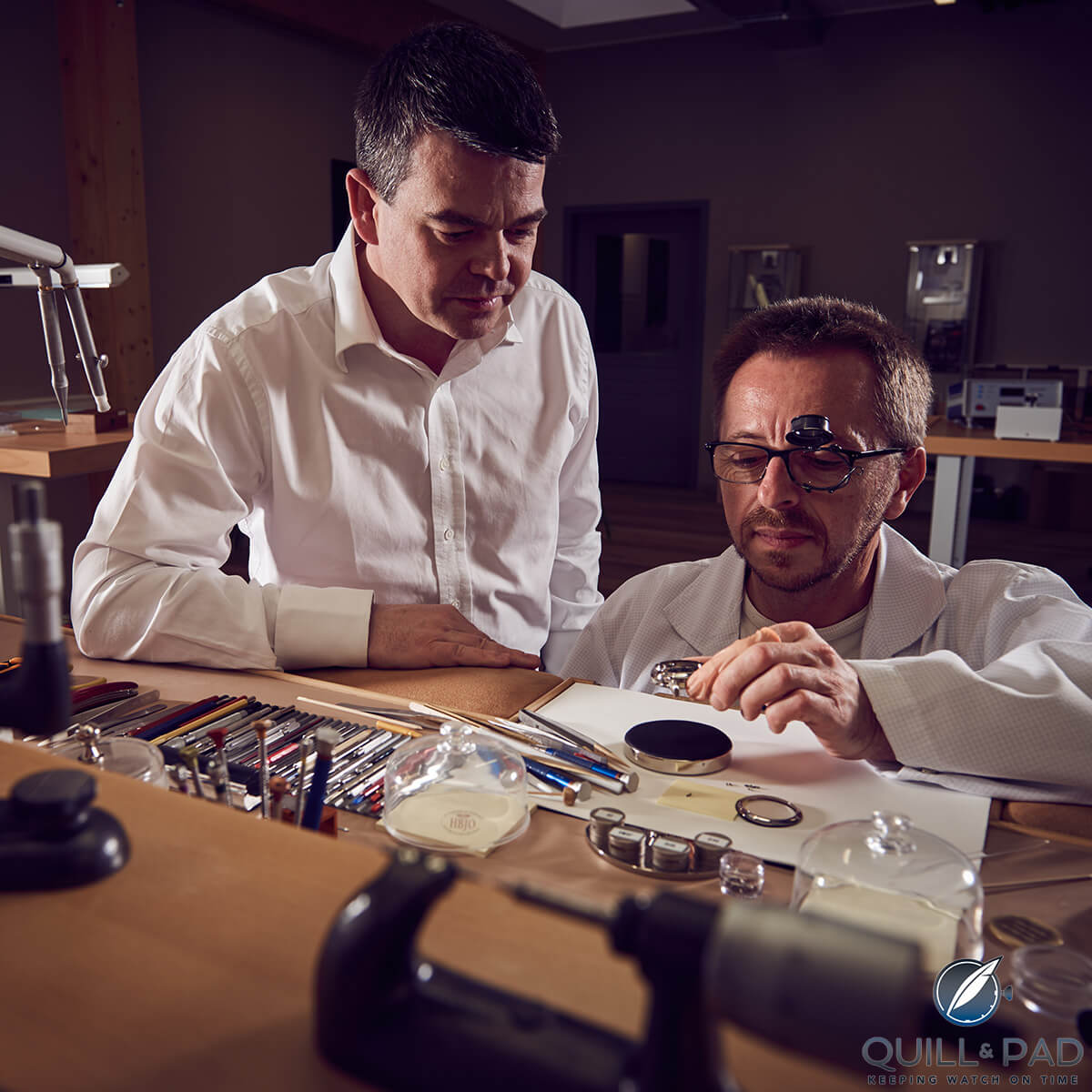
Romain Gauthier (left) and watchmaker Patrick Martin in the Le Sentier atelier
This also goes to show how humble Romain Gauthier is. He doesn’t look to be a figurehead or superstar name; he wants to create a family, a team that works well together and makes what some might call magic, and what he would call the culmination of the hard work of many talented people.
He understands, thanks to his personal philosophy, that the greatest creations are not of one man, but of many. The achievements of engineers, designers, watchmakers, machinists, finishers, and the multitude of skills involved make the watches all the better for this collaboration.
Gauthier’s drive, pragmatism, and passion have placed him in a unique spot in the industry, and he has done his best to earn that coveted position.
Gauthier deserves to be recognized for his future historical significance, and I am certain that future horology historians will agree that he helped shape watchmaking in the twenty-first century.
And now he gains a new title: the very first Quill & Pad Watchmaker of Historical Significance, a new club that will be home to the very best in watchmaking today.
For more information, please visit www.romaingauthier.com.
* This article was first published on May 13, 2018 at Watchmaker Of Historical Significance: Romain Gauthier.
You may also enjoy:
Why Romain Gauthier Is The Logical Heir Apparent To Philippe Dufour
Why I Bought It: Romain Gauthier Logical One
Romain Gauthier Insight Micro-Rotor Squelette Carbonium: Adding Lightness
In Focus: Romain Gauthier’s Breathtaking Patented Ruby Link Chain From Logical One
Why We Are In A Golden Age For Appreciating Superlative Hand-Finishing In Wristwatches
Why Do Ultra-High-End Watches Cost So Much? Hand-Finishing At Romain Gauthier Sheds Some Light
Leave a Reply
Want to join the discussion?Feel free to contribute!





















































Tim Mosso interviewed him recently, and he came across as honest, down-to-earth and very likeable. He was clearly very proud of his MBA, and how it enabled him to be successful at being a businessman as well as a watchmaker. Looking at his movements I’m guessing he’s up there among very few peers in the gold standard for finishing?
Yes, absolutely on all counts.
I wonder who’s on the list of companies he supplies. I know he did something for Chanel, but that’s where my knowledge ends. Like a Voutilainen dial or Andreas Strehler movement design, it’s got to be a great thing to have something Gauthier-made in or on your watch.
Yes, it would be. But unfortunately a lot of brands don’t see it that way and prefer to maintain secrecy about suppliers, sort of implying that what they produce was all made in-house. This is why we will never know where all his parts go….
A very enjoyable and interesting article – thank you.